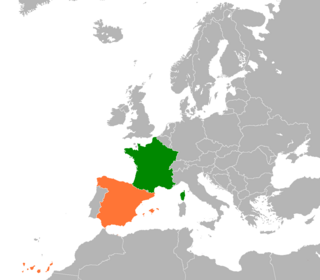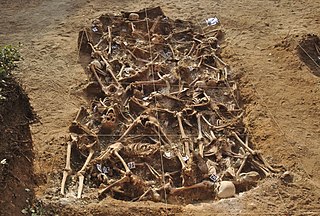
Before this period, the Nationalists had already become dominant, yet the outcome of the war was still not certain. This progressively changed as the Nationalist forces notched up several victories.

The Spanish Civil War (1936–1939) broke out with a military uprising in Morocco on July 17, triggered by events in Madrid. Within days, Spain was divided in two: a "Republican" or "Loyalist" Spain consisting of the Second Spanish Republic, and a "Nationalist" Spain under the insurgent generals, and, eventually, under the leadership of General Francisco Franco.

France–Spain relations are bilateral relations between France and Spain, in which both share a long border across the Pyrenees, other than one point which is cut off by Andorra. As two of the most powerful kingdoms of the early modern era, France and Spain fought a 24-year war until the signing of the Treaty of the Pyrenees in 1659. The treaty was signed on Pheasant Island between the two nations, which has since been a condominium, changing its allegiances each six months.

The Maquis were Spanish guerrillas who waged an irregular warfare against the Francoist dictatorship within Spain following the Republican defeat in the Spanish Civil War until the early 1960s, carrying out sabotage, robberies and assassinations of alleged Francoists as well as contributing to the fight against Nazi Germany and the Vichy regime in France during World War II. They also took part in occupations of the Spanish embassy in France.

The Aragon Offensive was an important military campaign during the Spanish Civil War, which began after the Battle of Teruel. The offensive, which ran from March 7, 1938, to April 19, 1938, smashed the Republican forces, overran Aragon, and conquered parts of Catalonia and the Levante.

The Catalonia Offensive was part of the Spanish Civil War. The Nationalist Army started the offensive on 23 December 1938 and rapidly conquered Republican-held Catalonia with Barcelona. Barcelona was captured on 26 January 1939. The Republican government headed for the French border. Thousands of people fleeing the Nationalists also crossed the frontier in the following month, to be placed in internment camps. Franco closed the border with France by 10 February 1939.

Le Vernet Internment Camp, or Camp Vernet, was a concentration camp in Le Vernet, Ariège, near Pamiers, in the French Pyrenees. It was built in 1918 as a barracks, but after World War I it was used as an internment camp for prisoners of war. From February 1939 to June 1944, it was used:

In the history of Spain, the White Terror describes the political repression, including executions and rapes, which were carried out by the Nationalist faction during the Spanish Civil War (1936–1939), as well as during the following years of the regime of General Francisco Franco. In the 1936–1975 period, Francoist Spain had many officially designated enemies: Loyalists to the Second Spanish Republic (1931–1939), Liberals, socialists of different stripes, Protestants, intellectuals, homosexuals, Freemasons, Romanis, Jews, blacks, immigrants, Basque, Catalan, Andalusian and Galician nationalists.

The Camp de Rivesaltes, also known as Camp Joffre, was an internment and transit camp in the commune of Rivesaltes in the department of Pyrénées-Orientales of the French Southern Zone during World War Two. Between August 11 and October 20, 1942, 2,313 foreign Jews, including 209 children were transferred from Rivesaltes via the Drancy internment camp to the Nazi extermination camp Auschwitz, where they were murdered. Serge Klarsfeld described the camp as the Drancy of the Southern Zone.

The Spanish Civil War was fought from 1936 to 1939 between the Republicans and the Nationalists. Republicans were loyal to the left-leaning Popular Front government of the Second Spanish Republic, and consisted of various socialist, communist, separatist, anarchist, and republican parties, some of which had opposed the government in the pre-war period. The opposing Nationalists were an alliance of Falangists, monarchists, conservatives, and traditionalists led by a military junta among whom General Francisco Franco quickly achieved a preponderant role. Due to the international political climate at the time, the war had many facets and was variously viewed as class struggle, a religious struggle, a struggle between dictatorship and republican democracy, between revolution and counterrevolution, and between fascism and communism. According to Claude Bowers, U.S. ambassador to Spain during the war, it was the "dress rehearsal" for World War II. The Nationalists won the war, which ended in early 1939, and ruled Spain until Franco's death in November 1975.
The Argelers concentration camp was an internment camp established in early February 1939 on the territory of the French commune of Argelès-sur-Mer for Spanish Republican refugees. Called La Retirada many of the refugees were members of the Spanish Republican Army (Ejército Popular Republicano) in the Northeast of Spain in the last months of the Spanish Civil War.
Camp of Septfonds, also called Camp of Judes, was a labor camp for men before and during World War II, located in southern France near Septfonds, established in 1939, and run by the French Third Republic and the Vichy government.

Mar Negro was an armed merchantman of the Nationalist Spanish Navy during the Spanish Civil War. The cargo ship was launched in 1930 along with her sister ship MV Mar Cantábrico, and after five years with the Compañía Marítima Del Nervión company, she was requisitioned by the Spanish Republican Navy in 1936. Captured by a group of Nationalist sympathizers from her crew off Algeria in 1937, she entered in service in 1938 after being converted to an auxiliary cruiser.

The Republican faction, also known as the Loyalist faction or the Government faction, was the side in the Spanish Civil War of 1936 to 1939 that supported the government of the Second Spanish Republic against the Nationalist faction of the military rebellion. The name Republicans was mainly used by its members and supporters, while its opponents used the term Rojos (Reds) to refer to this faction due to its left-leaning ideology, including far-left communist and anarchist groups, and the support it received from the Soviet Union. At the beginning of the war, the Republicans outnumbered the Nationalists by ten-to-one, but by January 1937 that advantage had dropped to four-to-one.

The final offensive of the Spanish Civil War took place between 26 March and 1 April 1939, towards the end of the Spanish Civil War. On 5 March 1939, the Republican Army, led by Colonel Segismundo Casado and the politician Julián Besteiro, rose against the socialist prime minister Juan Negrín, and formed a military junta, the National Defence Council to negotiate a peace deal. Negrín fled to France but the communist troops around Madrid rose against the junta, starting a civil war within the civil war. Casado defeated them and started peace negotiations with the Nationalists. Francisco Franco, however, was willing to accept only an unconditional surrender. On 26 March, the Nationalists started a general offensive and by 31 March, they controlled all of Spanish territory. Hundreds of thousands of Republicans were arrested and interned in concentration camps.
The Rieucros Camp was an internment camp on a forested hillside near Mende in the French department of Lozère that operated from January 1939 to February 1942. Prime Minister Édouard Daladier established the camp by decree on January 21, 1939, to isolate members of the International Brigades from French society after the defeat of the Second Spanish Republic and subsequent exile, known as la Retirada, in the Spanish Civil War. Other "suspicious and undesirable foreign men," sometimes accused of common law crimes, were also interned. After France's entry into World War II, authorities transferred the men to the camp of le Vernet and began to intern "suspicious and undesirable foreign women" in October 1939. Following the Battle of France, Rieucros fell in the southern unoccupied zone and the Vichy regime assumed control of the camp from Third Republican authorities. In February 1942, authorities transferred the entire camp population of women and children to the camp of Brens.

When, in 1939, World War II erupted in Europe, Catalonia was part of Spain led by the caudillo Francisco Franco, who declared Spain neutral in the conflict. The country was devastated by the recently finished Spanish Civil War, which resulted in the defeat of the Second Spanish Republic and the creation of the Spanish State, and Catalonia, who was an autonomous region under the Republican government (1931-1939) lost the whole of its self-government when the Nationalist army occupied the area.
María García Torrecillas was a Spanish assistant nurse and mid-wife who assisted in the delivery of around 300 babies while in exile in Vichy France as a result of the Spanish Civil War.
The Bérard-Jordana Agreement, also called Berard-Jordan Agreement in English, was a political treaty signed by France and Spain in Burgos on 25 February 1939. Its name is based on the two principal signatories, Léon Bérard for France and General Francisco Gómez-Jordana Sousa Jordana for Spain.

Camí de la Retirada refers to routes and paths in the eastern Pyrenees used by Republican exiles at the end of the Spanish Civil War. One of the best known paths, today signposted as a trail for hiking or biking, runs for 14 kilometres (8.7 mi) from Molló to Prats de Molló via Col d'Ares at 1,513 metres (4,964 ft) above sea level. It is estimated that about 100,000 people of all ages used this path in January and February, 1939.




















